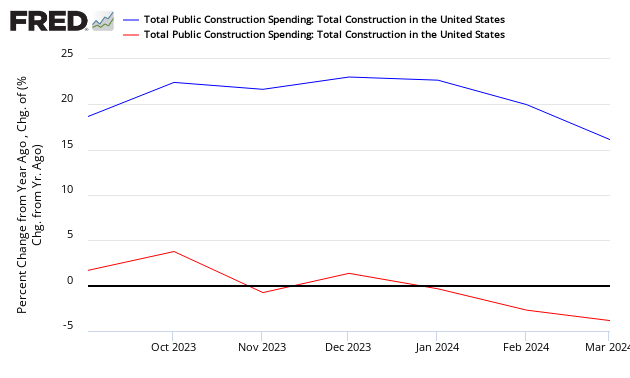Written by Steven Hansen
The headlines say construction spending was down, and was significantly below expectations. Consider this a weaker report than last month.
Analyst Opinion of Construction Spending
Public construction remained in contraction (and worsened) year-over-year whilst private construction insignificantly improved and remained in expansion. There was significant backward revision to the upside – but the rolling averages did decline. Also note that inflation is grabbing hold – and the inflation adjusted numbers are significantly worse than the headlines.
But the confusion is that construction spending does not correlate to construction employment – casting doubt on the validity of one or both data sets.
Econintersect analysis:
- Growth decelerated 2.0 % month-over-month and up 3.3 % year-over-year.
- Inflation adjusted construction spending up 2.0 % year-over-year.
- 3 month rolling average is 8.3 % above the rolling average one year ago, and decelerated 2.9 % month-over-month. As the data is noisy (and has so much backward revision) – the moving averages likely are the best way to view construction spending.
- Backward revision for the last 4 months has been upward.

- Down 1.0 % month-over-month and up 3.1 % year-over-year.
- Market expected from Bloomberg / Econoday 0.2 % to 0.7 % month-over-month (consensus +0.5) versus the -1.0 % reported
Construction spending (unadjusted data) was declining year-over-year for 48 straight months until November 2011. That was four years of headwinds for GDP.
Indexed and Seasonally Adjusted Total Construction Spending (blue line) and Inflation Adjusted (red line)

This month’s headline statement from US Census:
Construction spending during January 2017 was estimated at a seasonally adjusted annual rate of $1,180.3 billion, 1.0 percent (±1.0 percent)* below the revised December estimate of $1,192.2 billion. The January figure is 3.1 percent (±1.5 percent) above the January 2016 estimate of $1,144.9 billion.
PRIVATE CONSTRUCTION – Spending on private construction was at a seasonally adjusted annual rate of $897.0 billion, 0.2 percent (±0.8%)* above the revised November estimate of $894.8 billion. Residential construction was at a seasonally adjusted annual rate of $466.9 billion in December, 0.5 percent (±1.3%)* above the revised November estimate of $464.8 billion. Nonresidential construction was at a seasonally adjusted annual rate of $430.1 billion in December, nearly the same as (±0.8%)* the revised November estimate of $430.1 billion. The value of private construction in 2016 was $876.3 billion, 6.4 percent (±1.2%) above the $823.5 billion spent in 2015. Residential construction in 20Spending on private construction was at a seasonally adjusted annual rate of $911.6 billion, 0.2 percent (±0.8 percent)* above the revised December estimate of $909.4 billion. Residential construction was at a seasonally adjusted annual rate of $476.4 billion in January, 0.5 percent (±1.3 percent)* above the revised December estimate of $474.0 billion. Nonresidential construction was at a seasonally adjusted annual rate of $435.3 billion in January, nearly the same as (±0.8 percent)* the revised December estimate of $435.4 billion.16 was $456.2 billion, 5.2 percent (±2.1%) above the 2015 figure of $433.7 billion and nonresidential construction was $420.1 billion, 7.8 percent (±1.2%) above the $389.9 billion in 2015.
PUBLIC CONSTRUCTION – In January, the estimated seasonally adjusted annual rate of public construction spending was $268.7 billion, 5.0 percent (±1.8 percent) below the revised December estimate of $282.8 billion. Educational construction was at a seasonally adjusted annual rate of $69.2 billion, 2.7 percent (±2.5 percent) below the revised December estimate of $71.1 billion. Highway construction was at a seasonally adjusted annual rate of $86.7 billion, 3.3 percent (±4.1 percent)* below the revised December estimate of $89.6 billion.
Unadjusted Total Construction Spending Year-Over-Year (blue line) and Month-over-Month (red line) Change

Unadjusted Total Construction Spending Year-Over-Year (blue line) Growth

Unadjusted Private Construction Spending Year-Over-Year (blue line) and Month-over-Month (red line) Change

Unadjusted Public Construction Spending Year-Over-Year (blue line) and Month-over-Month (red line) Change

Private construction had been fueling construction growth.
Caveats on the Use of Construction Spending Data
Although the data in this series is revised for several months after issuing, the revision is generally minor. This series is produced by sampling – and the methodology varies by sector being sampled.
The headline data is seasonally adjusted. Econintersect uses the raw unadjusted data.Econintersect determines the month-over-month change by subtracting the current month’s year-over-year change from the previous month’s year-over-year change. This is the best of the bad options available to determine month-over-month trends – as the preferred methodology would be to use multi-year data (but the New Normal effects and the Great Recession distort historical data).
The data set for construction spending is not inflation adjusted. Econintersect adjusts using the BLS Producers Price Index – subindex New Construction (PCUBNEW-BNEW). However in the inflation adjusted graph in this post, FRED does not have this series – andEconintersect has used Producer Price Index: Finished Goods Less Energy (PPIFLE), Monthly, Seasonally Adjusted which has similar characteristics.
Construction (which historically is an major economic driver) is a literal shadow of its former self. Its contribution to GDP is down $400 billion from its peak level in 2006. The main driver of construction spending is the private sector. Here is the historical breakdown. The graph below uses US Census seasonally adjusted data.

Obvious from the above graph that public spending on construction is falling off, while private spending is slightly trending up. The overall effect is that construction spending is near the same place it was in early 2010.
include(“/home/aleta/public_html/files/ad_openx.htm”); ?>









